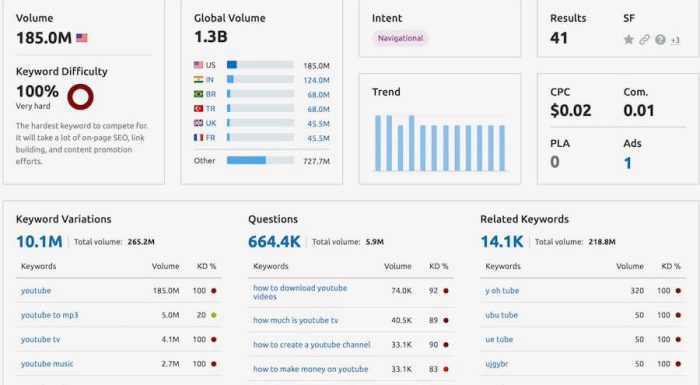https://nasacademy.com/blog/article/seo-keyword-research-for-beginners

Whether you’re looking to build your website on Google, or your videos on YouTube, the only way you’re going to grow is if you start ranking. And ranking means being able to do proper SEO keyword research, to make sure your content is aligning with what your audience is searching for.

But if you’re new to the world of SEO or content creation, you might not know how to get started. That’s why we’ve prepared this step-by-step guide to help you understand SEO and keyword research, and how you can use them to get your content ranking.
SEO stands for Search Engine Optimization, which is the process of improving your content or site so that it shows at the top of search results.
To understand SEO, you have to understand how search engines work. In short, when you post content, Google scans the pages to find out what your content is about. Then, if somebody searches for something that can be found on your page, it will suggest it to the user. However the highest ranking page will be the one it believes will be of most value to the user.
That’s why it’s important to know what people are searching for, so you can optimize your content to be ranked as the most useful and allow people to discover it.
This is where SEO keyword research comes in.
While there are many ways to improve your SEO, keyword research is a very important step. SEO keyword research is the process of finding specific words that are associated with your content that people are searching for online. By finding and using keywords, you help your article or video show up when people search for those keywords.

As you do your keyword research, you will then use those keywords in your content to help it rank. There are a few different ways you can perform keyword research to find what people are searching for, and pick out the ones that will help you get noticed online.
Before you begin doing in-depth keyword research, you first need to identify words that are connected with the content that you are trying to optimize. For example, if your website is about crafts, come up with a list of words people would search for. For example: crafts, cards, DIY, art.
These are going to be the base words for the keyphrases you’re going to be searching for.
Once you’ve come up with a series of words associated with your content, a free way of finding out keywords is to use Google. Type in one of your words, and see a list of menu items pop up.

Here you’ll see a list of common searches ranked from most popular to least popular. These are good ideas of keywords to include in your article. You can also put an underscore in front of the word or phrase or in between words to find even more, longtail (less popular) keyphrases. You can also find more common searches at the bottom of the Google results page.
If you really want to do a deep-dive and get the best results with your SEO keyword research, use a keyword research tool. You can use Google Keyword Planner for free, as well as Google Trends to see the popularity of certain terms and topics over time. But in order to get the best keyword research tool, you may have to invest some money.
A great option for a keyword research tool is Semrush. There are many others, and most will give you access to all of the information you need to effectively do your SEO keyword research.
Search for some of your base words or phrases that you’ve found on Google. With tools like Semrush, you will see there’s an option to find exact or related matches, and even to filter them by the types of phrases – like related, or specifically those worded in questions.

You can also take the keywords you find through your keyword research tool, and put them back into the Google search bar to find longer, less popular keyphrases that people search for online.
But, most importantly, the great thing about keyword research tools is that they collect data and statistics around your keywords. This will give you valuable information when picking the right keywords for your content. They also help you discover keywords that your competitors are using, to help you better compete and rank against them.
Another good way to perform SEO keyword research is to take a look at what competitors are using as their keywords. You can do this through Semrush and other keyword research tools.
To find your competitors, make sure to pick top-ranking sites that are comparable to your site. For example, if you’re a craft blog, and an Etsy page comes up first when you search “stained glass”, Etsy wouldn’t be a competitor because it is an e-commerce site, and way too big for your blog to compete with. Instead, pick other craft blogs like yours that create similar content to you and use them for reference. Otherwise, you’ll be fighting a battle you’ll never be able to win.

You can input the link of your competitors into your keyword research tool, and discover what other keywords they are using that you can compete for. Then, you can do the same process as you did before where you input these searches into Google and try to find other long-tail keywords through Google’s search suggestions.
If you use a keyword research tool like Semrush, you’ll find that it gives you a lot of options for words, and a bunch of different numbers and statistics. All of this data can be confusing if you’re new to SEO keyword research. So, here’s a basic breakdown of some of the key elements you should look at when deciding on which keywords to include in your content:


There are many different statistics and pieces of data that keyword research tools will give you, and it’s worth doing a deep dive into them to see which ones are going to be most helpful to you. Watch a few tutorials on whatever keyword tool you are using and try to build up a strategy that works for your goals as a brand.
As you choose which selection of keywords to use for your content, make sure to pick a variety of different ones. Mix up the phrasing of your keywords – from statements, to questions. There are many different kinds of keywords out there, and by including different phrases and words makes it more likely that you’re going to cover multiple bases and searches, and hopefully get your content ranking.
Learn to become a pro at search engine optimization from SEO Hacker Academy. If you’re looking to upskill your SEO skills for your business or creator journey, this is your shot to learn from an expert speaker and entrepreneur behind his own SEO agency, Sean Si. Sign up for the waitlist today.
By Admin Nas Academy
By Admin Nas Academy